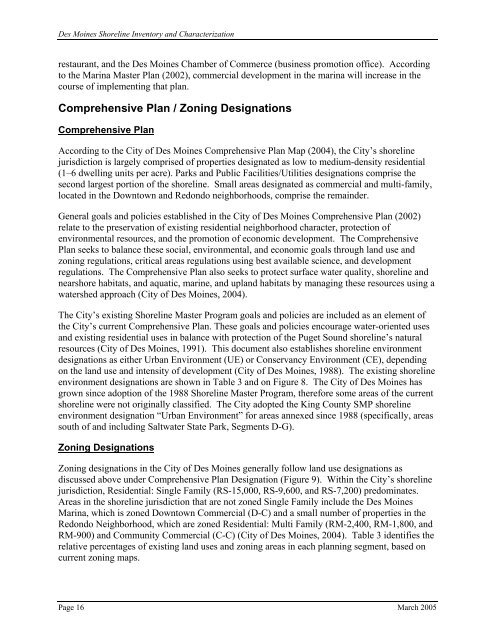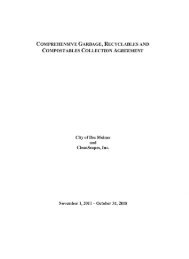CITY OF DES MOINES SHORELINE MASTER PROGRAM
CITY OF DES MOINES SHORELINE MASTER PROGRAM
CITY OF DES MOINES SHORELINE MASTER PROGRAM
You also want an ePaper? Increase the reach of your titles
YUMPU automatically turns print PDFs into web optimized ePapers that Google loves.
Des Moines Shoreline Inventory and Characterization<br />
restaurant, and the Des Moines Chamber of Commerce (business promotion office). According<br />
to the Marina Master Plan (2002), commercial development in the marina will increase in the<br />
course of implementing that plan.<br />
Comprehensive Plan / Zoning Designations<br />
Comprehensive Plan<br />
According to the City of Des Moines Comprehensive Plan Map (2004), the City’s shoreline<br />
jurisdiction is largely comprised of properties designated as low to medium-density residential<br />
(1–6 dwelling units per acre). Parks and Public Facilities/Utilities designations comprise the<br />
second largest portion of the shoreline. Small areas designated as commercial and multi-family,<br />
located in the Downtown and Redondo neighborhoods, comprise the remainder.<br />
General goals and policies established in the City of Des Moines Comprehensive Plan (2002)<br />
relate to the preservation of existing residential neighborhood character, protection of<br />
environmental resources, and the promotion of economic development. The Comprehensive<br />
Plan seeks to balance these social, environmental, and economic goals through land use and<br />
zoning regulations, critical areas regulations using best available science, and development<br />
regulations. The Comprehensive Plan also seeks to protect surface water quality, shoreline and<br />
nearshore habitats, and aquatic, marine, and upland habitats by managing these resources using a<br />
watershed approach (City of Des Moines, 2004).<br />
The City’s existing Shoreline Master Program goals and policies are included as an element of<br />
the City’s current Comprehensive Plan. These goals and policies encourage water-oriented uses<br />
and existing residential uses in balance with protection of the Puget Sound shoreline’s natural<br />
resources (City of Des Moines, 1991). This document also establishes shoreline environment<br />
designations as either Urban Environment (UE) or Conservancy Environment (CE), depending<br />
on the land use and intensity of development (City of Des Moines, 1988). The existing shoreline<br />
environment designations are shown in Table 3 and on Figure 8. The City of Des Moines has<br />
grown since adoption of the 1988 Shoreline Master Program, therefore some areas of the current<br />
shoreline were not originally classified. The City adopted the King County SMP shoreline<br />
environment designation “Urban Environment” for areas annexed since 1988 (specifically, areas<br />
south of and including Saltwater State Park, Segments D-G).<br />
Zoning Designations<br />
Zoning designations in the City of Des Moines generally follow land use designations as<br />
discussed above under Comprehensive Plan Designation (Figure 9). Within the City’s shoreline<br />
jurisdiction, Residential: Single Family (RS-15,000, RS-9,600, and RS-7,200) predominates.<br />
Areas in the shoreline jurisdiction that are not zoned Single Family include the Des Moines<br />
Marina, which is zoned Downtown Commercial (D-C) and a small number of properties in the<br />
Redondo Neighborhood, which are zoned Residential: Multi Family (RM-2,400, RM-1,800, and<br />
RM-900) and Community Commercial (C-C) (City of Des Moines, 2004). Table 3 identifies the<br />
relative percentages of existing land uses and zoning areas in each planning segment, based on<br />
current zoning maps.<br />
Page 16 March 2005



